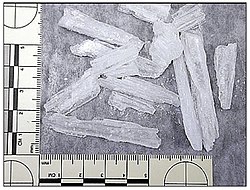Isopropylbenzylamine

| |

| |
| Names | |
|---|---|
| Preferred IUPAC name
N-Benzylpropan-2-amine | |
| Other names
N-(Phenylmethyl)propan-2-amine
Isopropylbenzylamine | |
| Identifiers | |
3D model (JSmol)
|
|
| ChemSpider | |
| ECHA InfoCard | 100.002.789 |
PubChem CID
|
|
| UNII | |
CompTox Dashboard (EPA)
|
|
| Properties | |
| C10H15N | |
| Molar mass | 149.237 g·mol−1 |
Except where otherwise noted, data are given for materials in their standard state (at 25 °C [77 °F], 100 kPa). | |
| Infobox references | |
N-isopropylbenzylamine is a compound that has appeared in chemical literature often playing an intermediary role in applications of experimental synthesis and novel organic transformations. Despite having limited documented uses, it is most well known for having previously come to the attention of the DEA due to being used by illicit methamphetamine manufacturers as a diluent of or substitute for methamphetamine, with many recorded sightings occurring in the years 2007-2008.[1][2][3][4] As of 2018, researchers from the DEA associated with the Methamphetamine Profiling Program, which categorizes route-specific and other impurities in seized drug samples, has stated that isopropylbenzylamine appears only "occasionally".[5] This compound is a chain isomer of methamphetamine that exhibits the same chemical formula and molar mass giving their hydrochloride salts similar physical properties, such as relatively close melting points and comparable appearance. Consequently, it can be used as a substitute or diluent of methamphetamine without this being obvious to users, though the differing melting points and various attributes of its presentation such as softer or more easily broken crystals have been noted as a possible indication of its presence.[4] It currently is unknown to be a controlled substance in any jurisdiction. Isopropylbenzylamine is not thought to have any stimulant effects in its own right, though anecdotal reports suggest that it may be associated with side effects such as headaches and confusion which are not typically associated with methamphetamine itself.[citation needed] The toxicity of N-isopropylbenzylamine has not been studied.[6][3] Other "cutting agents" found to have been used for methamphetamine include the related compounds methylbenzylamine and ethylbenzylamine, as well as dimethylsulfone.[2][7]

References[]
- ^ "Northwest Association of Forensic Scientists Fall 2008 Newsletter" (PDF). 2008. Retrieved 12 October 2019.
- ^ Jump up to: a b N-BENZYLMETHYLAMINE HCL AND N-BENZYLETHYLAMINE HCL ("ICE" AND CRYSTAL METHAMPHETAMINE MIMICS) IN THE SOUTHWEST. Microgram Bulletin, August 2007
- ^ Jump up to: a b VERY LARGE SEIZURE OF N-ISOPROPYLBENZYLAMINE HYDROCHLORIDE IN BAKERSFIELD, CALIFORNIA. Microgram Bulletin, April 2008
- ^ Jump up to: a b Sanderson RS. Identification of N-Methylbenzylamine Hydrochloride, N-Ethylbenzylamine Hydrochloride, and N-Isopropylbenzylamine Hydrochloride. Microgram Journal January–June 2008; 6(1-2)
- ^ Li, Li; Brown, Jaclyn L.; Toske, Steven G. (2018). "Simultaneous detection and quantitation of organic impurities in methamphetamine by ultra-high-performance liquid chromatography–tandem mass spectrometry, a complementary technique for methamphetamine profiling". Drug Testing and Analysis. 10 (7): 1209–1219. doi:10.1002/dta.2388. ISSN 1942-7611. PMID 29633543.
- ^ N-ISOPROPYLBENZYLAMINE HYDROCHLORIDE (AS “ICE” METHAMPHETAMINE MIMICS) ON THE WEST COAST. Microgram Bulletin, March 2008
- ^ Weston, Robert G. (2010). "Quick Screening of Crystal Methamphetamine/Methyl Sulfone Exhibits by Raman Spectroscopy". Journal of Forensic Sciences. 55 (4): 1068–1075. doi:10.1111/j.1556-4029.2010.01336.x. ISSN 0022-1198. PMID 20345801. S2CID 39065054.
- Drug culture
- Illegal drug trade
- Methamphetamine
- Amines
- Isopropyl compounds
- Benzyl compounds